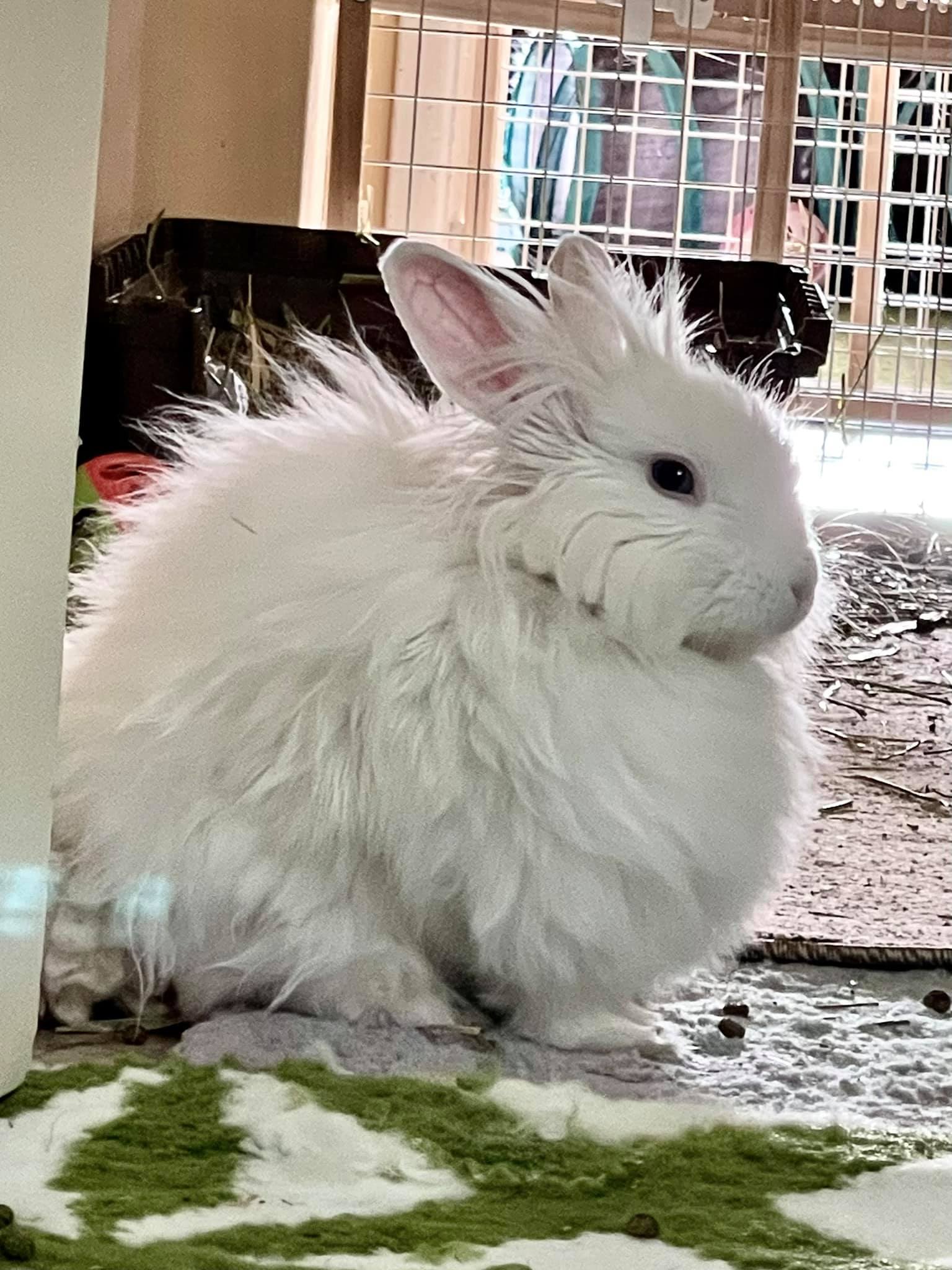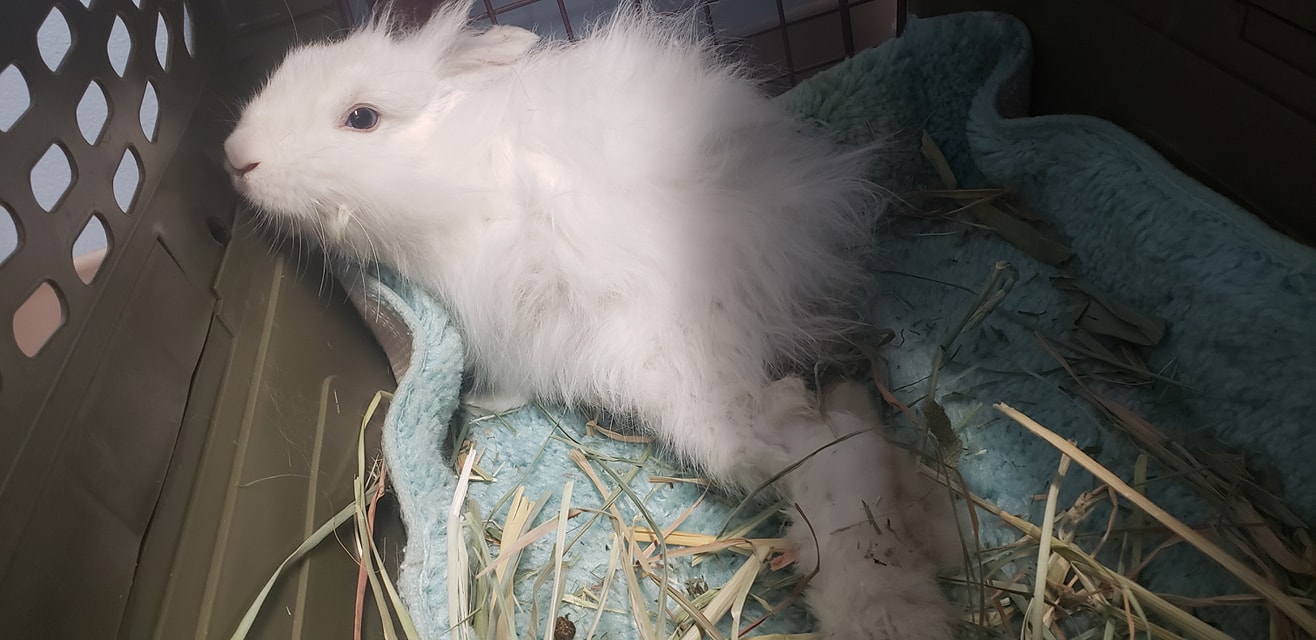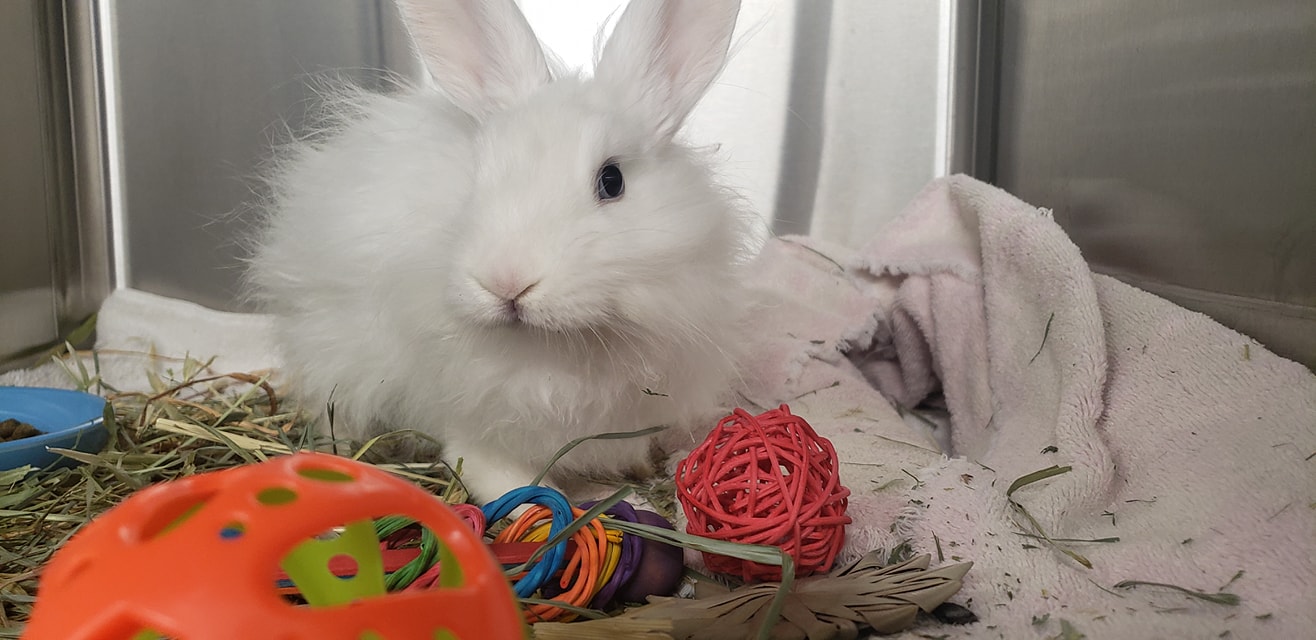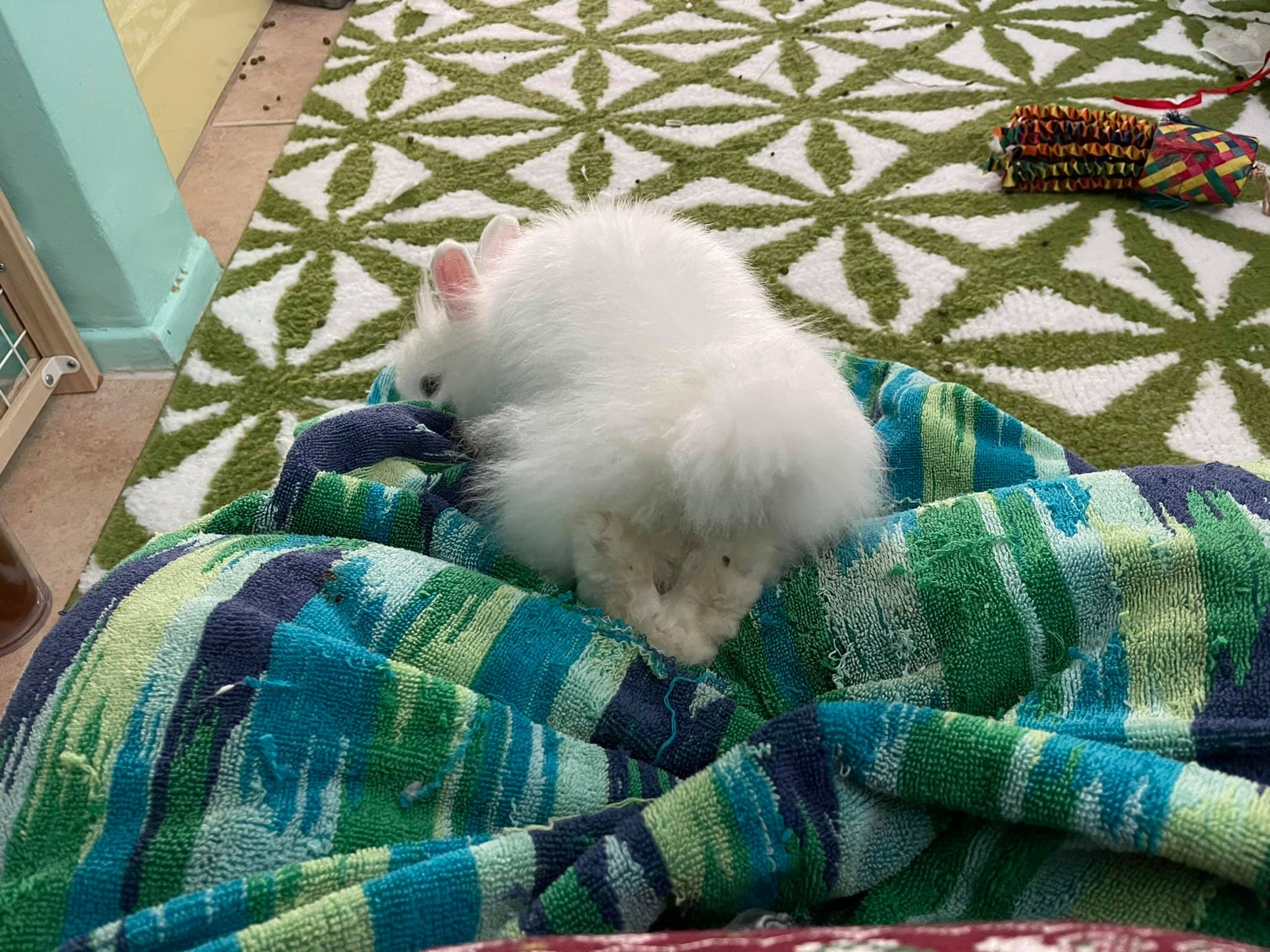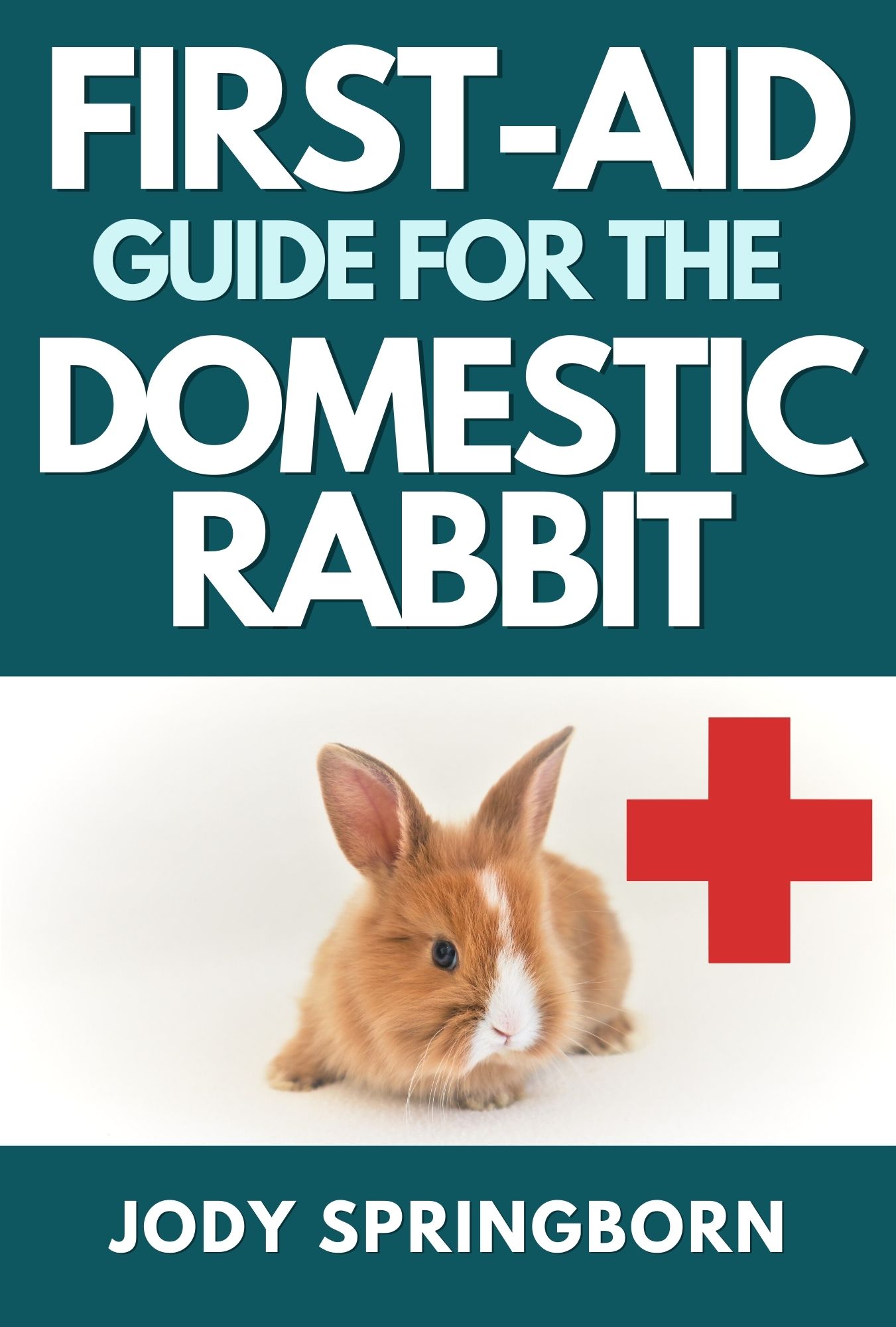- Home
- Rear End Paralysis
Rear End Paralysis
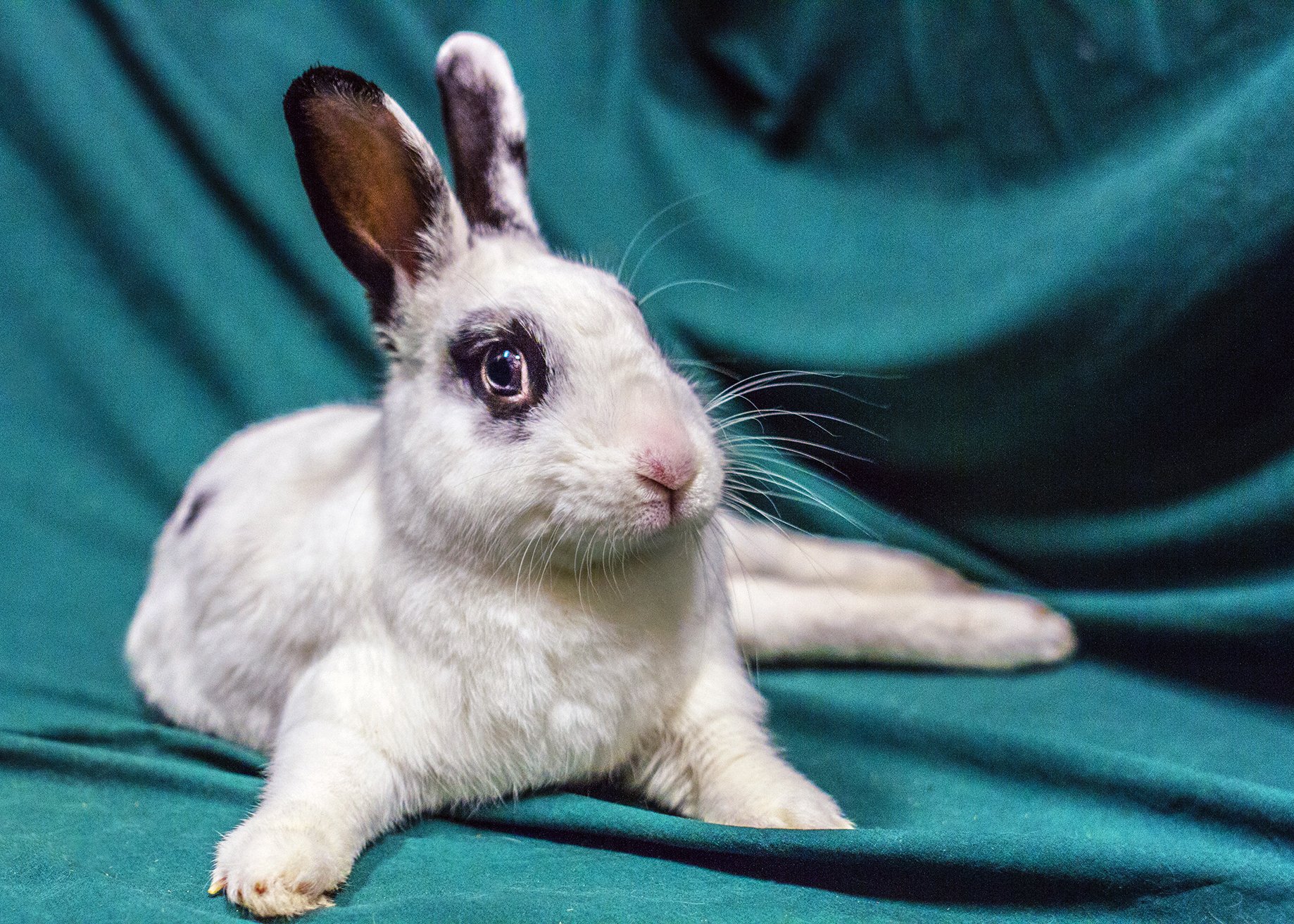 Handsome Diamond
Handsome DiamondPhoto by Dustin Yoder taken at BunnyLuv Rabbit Resource Center.
Key Points:
- Rear end paralysis can be due to either injury or disease.
- A rabbit may recover, depending on the cause, the age of the bunny and quality of care.
- If the condition is permanent, the affected bunny can still have a good quality of life.
- Working with a vet and physical therapist (if available) and providing supportive care are all helpful.
Losing the Ability to Hop
Rear end paralysis in rabbits is not uncommon. Injuries to the back or legs as well as congenital or age-related diseases can all impact mobility. There are several neurological diseases and conditions that can cause either full or partial paralysis (called paresis), but this article will just focus on the most common reasons.
Rear end paralysis does not necessarily mean a death sentence for the bunny. Often, with appropriate treatment and care, a paralyzed rabbit can still maintain a good quality of life for several years.
Signs of Rear End Paralysis
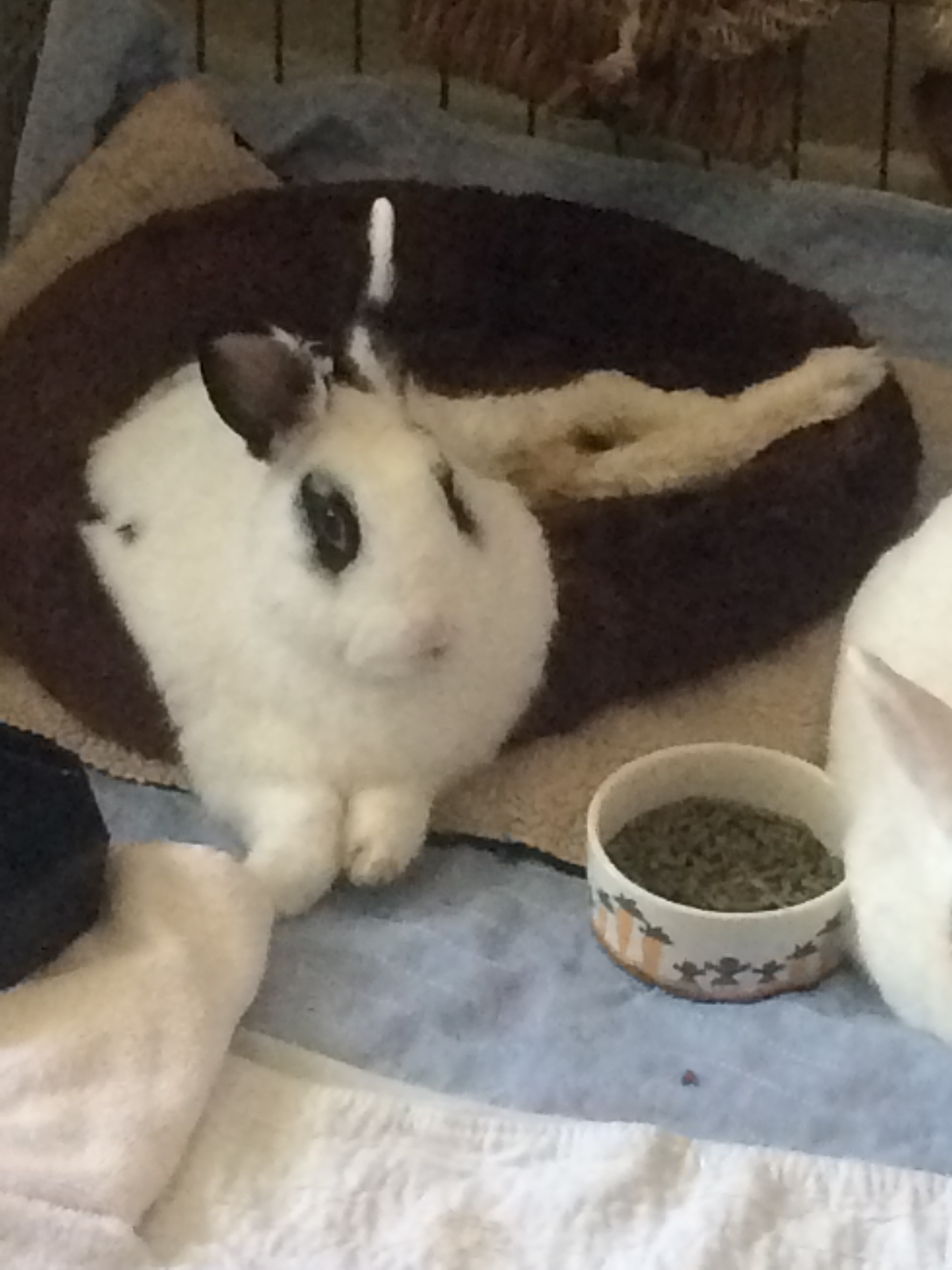 Diamond sitting pretty.
Diamond sitting pretty.Injuries to the back and legs result in immediate disruption to normal movement. What signs are present depends on the location of the injury, but they may include the following:
- Inability to stand or hop
- Dragging one or both hind legs
- Falling over
- Loss of bladder and/or bowel control
- Pain
In the case of age-related diseases or Encephalitozoon cuniculi (E. cuniculi), symptoms usually appear gradually. Rabbits may not lose control of their bladder or bowel functions, but it may be harder for them to get into the proper position to urinate or reach their cecotropes. That may result in urine scald, puddles on the floor and/or poopy butt.
They may not be able to jump into their litter box anymore or be unsteady when they stand. They may drag their feet when they move. They may struggle to stand up after lying down. They may even lose their balance and fall over. Often times, if these rabbits are still able to hop, their hind end may slant to one side.
These signs may be observed for several weeks before the bunny is finally down on his side. Rabbits will not recover from E. cuniculi or these degenerative conditions, but medication and supportive treatment can greatly slow down the process and extend quality of life.
Causes of Rear End Paralysis
Injury or Disease Related
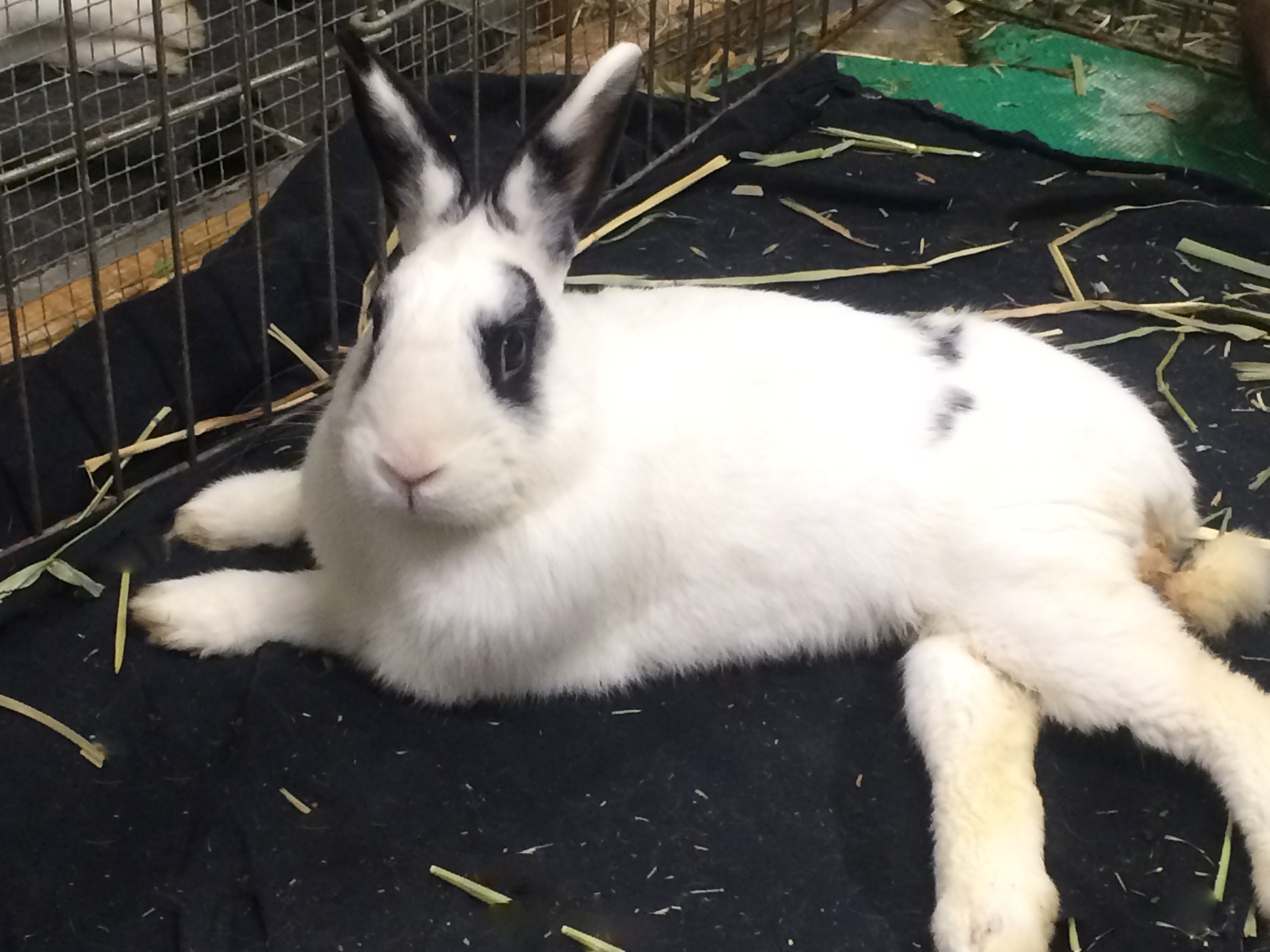 Diamond was approximately a year old when he suffered a spinal compression due to an overtly playful dog. Fortunately, the injury only affected his mobility and did not compromise his bladder or digestive function.
Diamond was approximately a year old when he suffered a spinal compression due to an overtly playful dog. Fortunately, the injury only affected his mobility and did not compromise his bladder or digestive function.Sudden paralysis may be caused by trauma to the legs, pelvis or spine. This may include being dropped or jumping down from a couch, bed, the owner's arms or any other considerable height. Improper handling which causes the bunny to panic, twist and kick, may also injure the back.
If the bunny shares his home with dogs and cats, physical trauma may occur with chasing or playful roughhousing. It's important to always supervise interactions between your rabbit and other pets and recognize the body language of each animal, especially if you have an exuberant puppy.
There may also be a general weakness associated with an infection (bacterial or parasitic) or other illness. Certain diseases like cancer can also affect the bones, making them brittle and susceptible to fractures and breaks. Often the first sign you will see from the rabbit is lameness or an unwillingness to move. The vet can determine the full extent of the problem through diagnostics.
Certain birth defects, such as splay leg, can also affect mobility. The impact of these defects varies. Sometimes these defects can be corrected through physical therapy or surgery, while in other instances, the disability is minor and the bunny can adapt to the inconvenience quickly.
Parsnip Malone - a ZCRR Sanctuary Rabbit
Broken bones does not always mean permanent disability, nor does it automatically signal that the bunny needs to be euthanized immediately . The type of injury or disease, the age of the bunny, the skill of the vet and ability and willingness of the caretaker all are significant factors a rabbit's potential recovery.
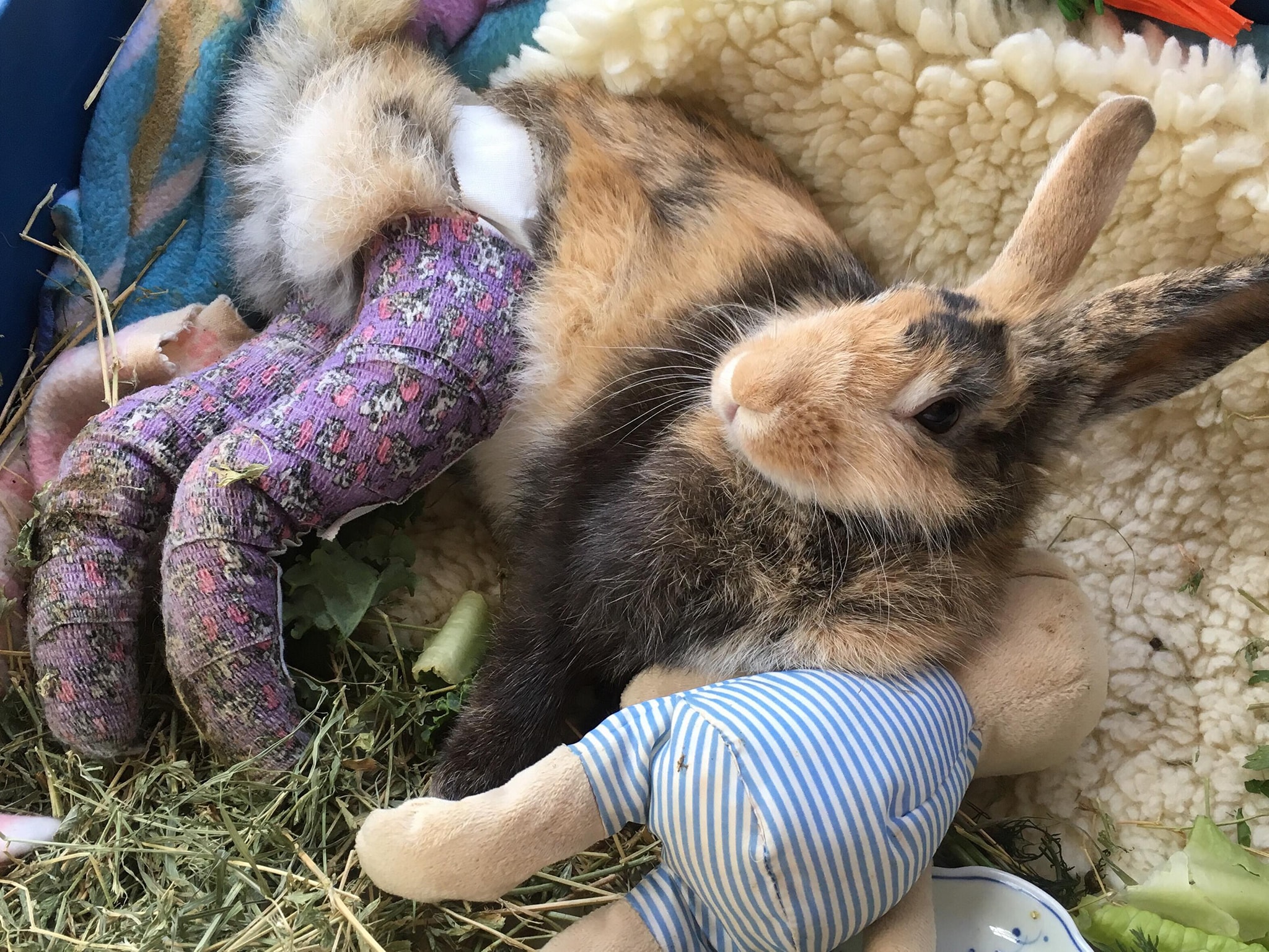 Parsnip Malone is a Zooh Corner Rabbit Rescue Sanctuary Rabbit. In 2018, Zooh Corner was contacted by King's County Animal Shelter asking if they could help with a young injured bunny they had just received. It turned out the tibia in both legs were shattered. Since she was such a young bunny, the rescue and their vet, Dr. Kanfer, tried to splint the legs to see if they would heal properly. Parsnip Malone is a Zooh Corner Rabbit Rescue Sanctuary Rabbit. In 2018, Zooh Corner was contacted by King's County Animal Shelter asking if they could help with a young injured bunny they had just received. It turned out the tibia in both legs were shattered. Since she was such a young bunny, the rescue and their vet, Dr. Kanfer, tried to splint the legs to see if they would heal properly. |
 Parsnip made a full recovery. In a few months, she regained full use of her legs. She now spends her day running, jumping, playing and looking adorable for the camera. Parsnip made a full recovery. In a few months, she regained full use of her legs. She now spends her day running, jumping, playing and looking adorable for the camera.Photos courtesy of Zooh Corner Rabbit Rescue |
Age-Related Causes
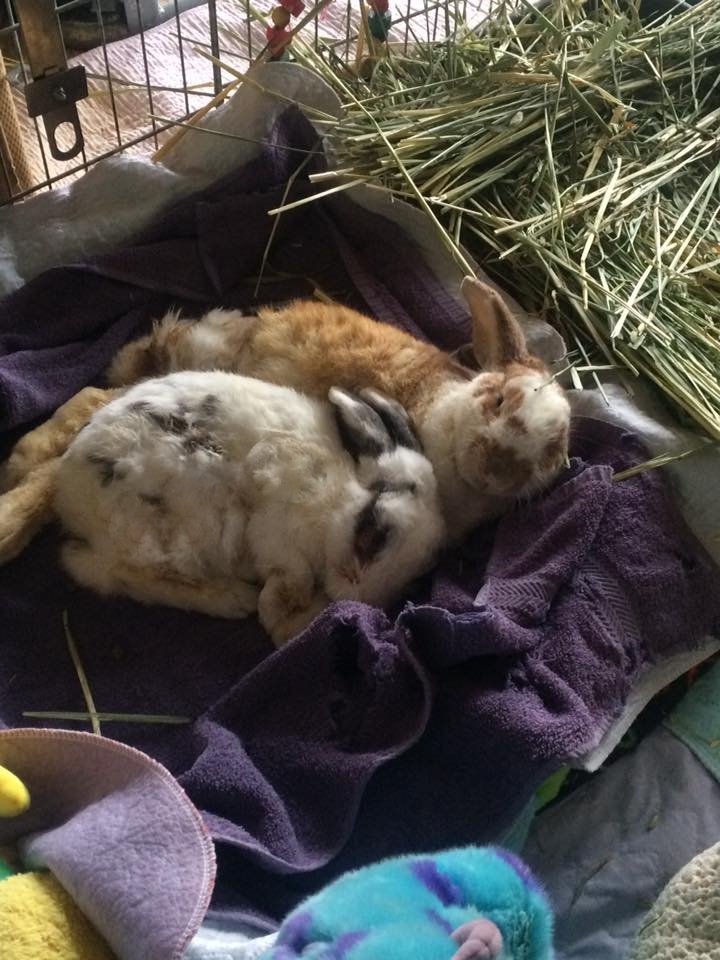 Nat (black and white) loved keeping his friend Benji company. At the time of this picture, Benji was about 12-years-old and could no longer stand. He took medication for both arthritis and spondolysis.
Nat (black and white) loved keeping his friend Benji company. At the time of this picture, Benji was about 12-years-old and could no longer stand. He took medication for both arthritis and spondolysis.Just like in humans and other mammals, age-related issues such as arthritis and spondylosis are very common in rabbits. Arthritis is the inflammation of one or more joints. Sometimes you can feel the swelling in the knees, elbows, shoulders, ankles and wrists.
Spondylosis in the spine occurs when bone spurs in the vertebrae cross over to the next vertebrae and eventually fuse together. The progression of the disease is slow with varying degrees of discomfort for the bunny. However, the end result is reduced flexibility. The rabbit will have a harder time running, jumping into the litter box, grooming and reaching his cecotropes. It may also discourage bending down to eat or drink.
Sometimes the intervertebral discs, which are the cushions found between the vertebrae, deteriorate with age. These discs act like shock absorbers, so if they tear, bulge or wear thin, pressure is placed on the spinal cord, causing pain and affecting function. What sort of functions are compromised depends on the location of the weakened disc.
Encephalitozoon cuniculi (E. cuniculi)
 Poppy (the red-head) had severe head tilt along with rear-end paralysis. Both conditions were most likely related to E.cuniculi.
Poppy (the red-head) had severe head tilt along with rear-end paralysis. Both conditions were most likely related to E.cuniculi.E. cuniculi is a microsporum parasite that is currently classified as a type of fungus. It is very common in domestic rabbits. Some of the clinical signs seen include cataracts, various renal issues, head tilt, seizures and rear end paralysis.
Depending on which source you read, 50%-80% of all domestic rabbits have been exposed. However, this does not mean every single one of these exposed rabbits will become sick. In fact, only a small percentage ever show symptoms. Symptoms usually appear when the bunny's immune system becomes compromised either due to illness, stress and/or age.
Although E. cuniculi is common among rabbits, there is surprisingly little information about how to definitively diagnose and treat a suspected E. cuniculi infection. Many vets may preemptively treat for E. cuniculi because diagnostic tests are not always informative and a 28-day course of fenbendazole (brand name: Panacur®) can be safely used on most rabbits. Fenbendazole will not cure the bunny from E. cuniculi, but it can better manage symptoms.
Further discussion of this disease will be discussed in later articles on this website.
Diagnosing and Treating Rear End Paralysis
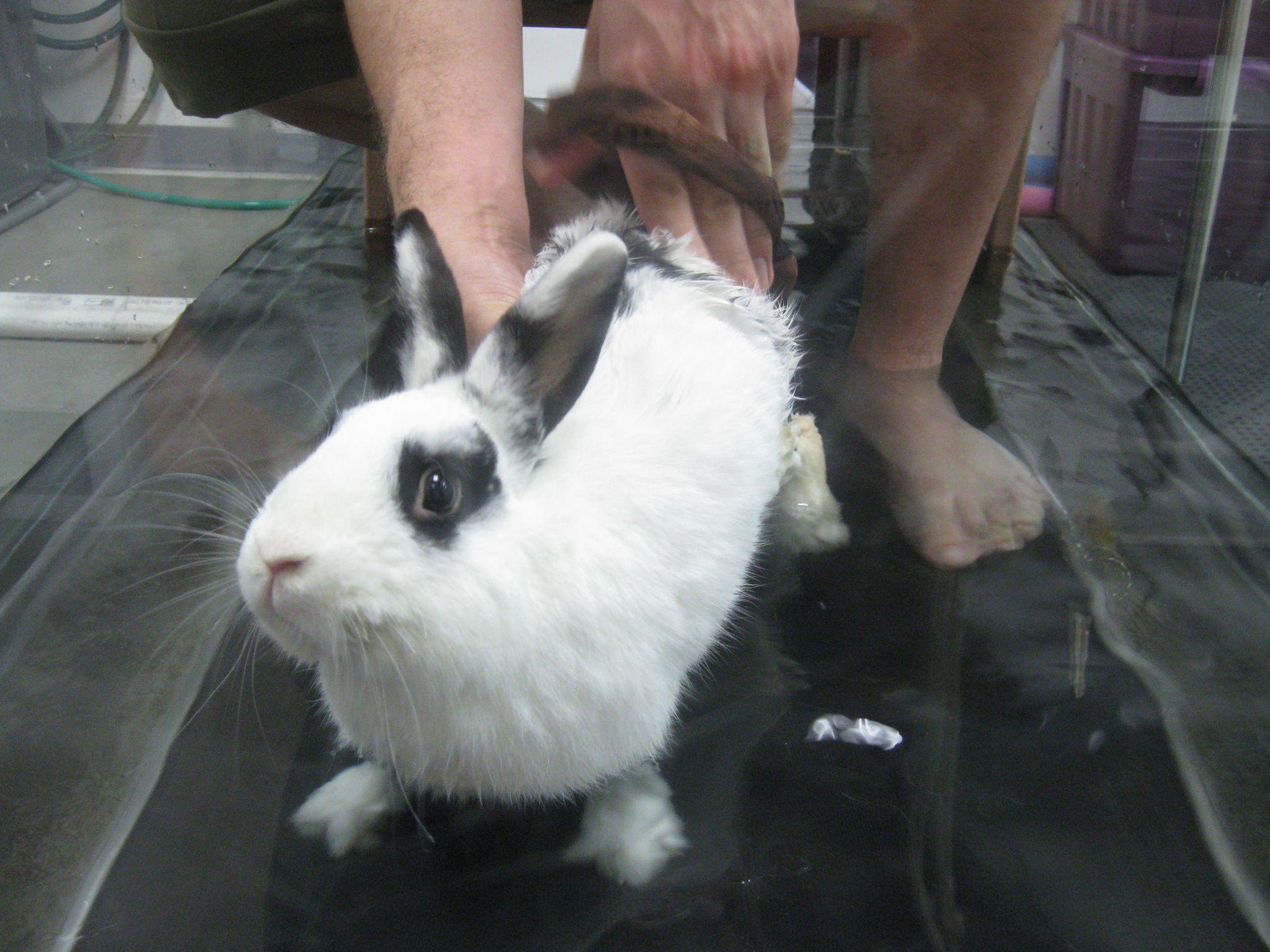 Diamond doing his underwater treadmill exercises at C.A.R.E (California Animal Rehabilitation in Los Angeles, CA).
Diamond doing his underwater treadmill exercises at C.A.R.E (California Animal Rehabilitation in Los Angeles, CA).Diagnosing rear end paralysis will require a thorough physical examination by the vet and include x-ray and blood work. Depending on the situation, the vet may also request CT (computerized tomography) or MRI (Magnetic resonance imaging) scans to get a more detailed look.
If the rear end paralysis is due to an injury, the vet will usually prescribe pain medication and confinement to give the body a chance to heal and stabilize on its' own. Confinement may entail a smaller pen or even a cage (depending on how small the bunny is). This would be the equivalent of bed rest for humans. The bunny may need to have his bladder expressed several times a day. This is a process in which you physically push on the bladder to empty it. If the vet believes this will be necessary, you will be shown how to do this properly. Syringe feeding and sub-q fluids (injecting prescribed fluids just underneath the skin) may also be needed. Again, if you are not familiar with the process, the vet will show you how it's done.
Confinement, syringe feeding, expressing the bladder and administering fluids is usually temporary. However, pain medication may be something the rabbit may need daily for an extended period. The most common one prescribed is meloxicam (usually sold under the brand name of Metacam®), which is in a class of drugs called NSAIDs (like Advil or Aleve available for humans). Depending on the issue, the vet may also prescribed gabapentin (used to reduce nerve pain). Tramadol, butorphanol and buprenorphine are opioids that can be used if the rabbit is in moderate to severe pain, or if meloxicam is not advised because of kidney issues. One common side effect of using opioids is drowsiness. If the rabbit becomes too sleepy to eat, he will need additional syringe feeding and the dose will need to be adjusted.
If arthritis and spondylosis are the issue, the vet will typically prescribe meloxicam and/or gabapentin, unless contraindicated. Since E. cuniculi is difficult to diagnose, your vet may also recommend a 28-day course of fenbendazole (Panacur). If E. cuniculi is the primary cause of the rear end paralysis, you may notice some improvement in your bunny. However, keep in mind that there is no cure for E. cuniculi. The medication can only ease symptoms.
Surgery is not usually performed, unless the cause is something that can be fixed surgically, such as a broken leg, a damaged intervertebral disc, amputation or removing a tumor.
If you are looking for homeopathic alternatives, discuss with your vet your wishes. Your vet may refer you to a homeopathic vet or adjust your bunny's medication before recommending a certain oil or tablet. Never administer homeopathic medicines without consulting with your veterinarian first.
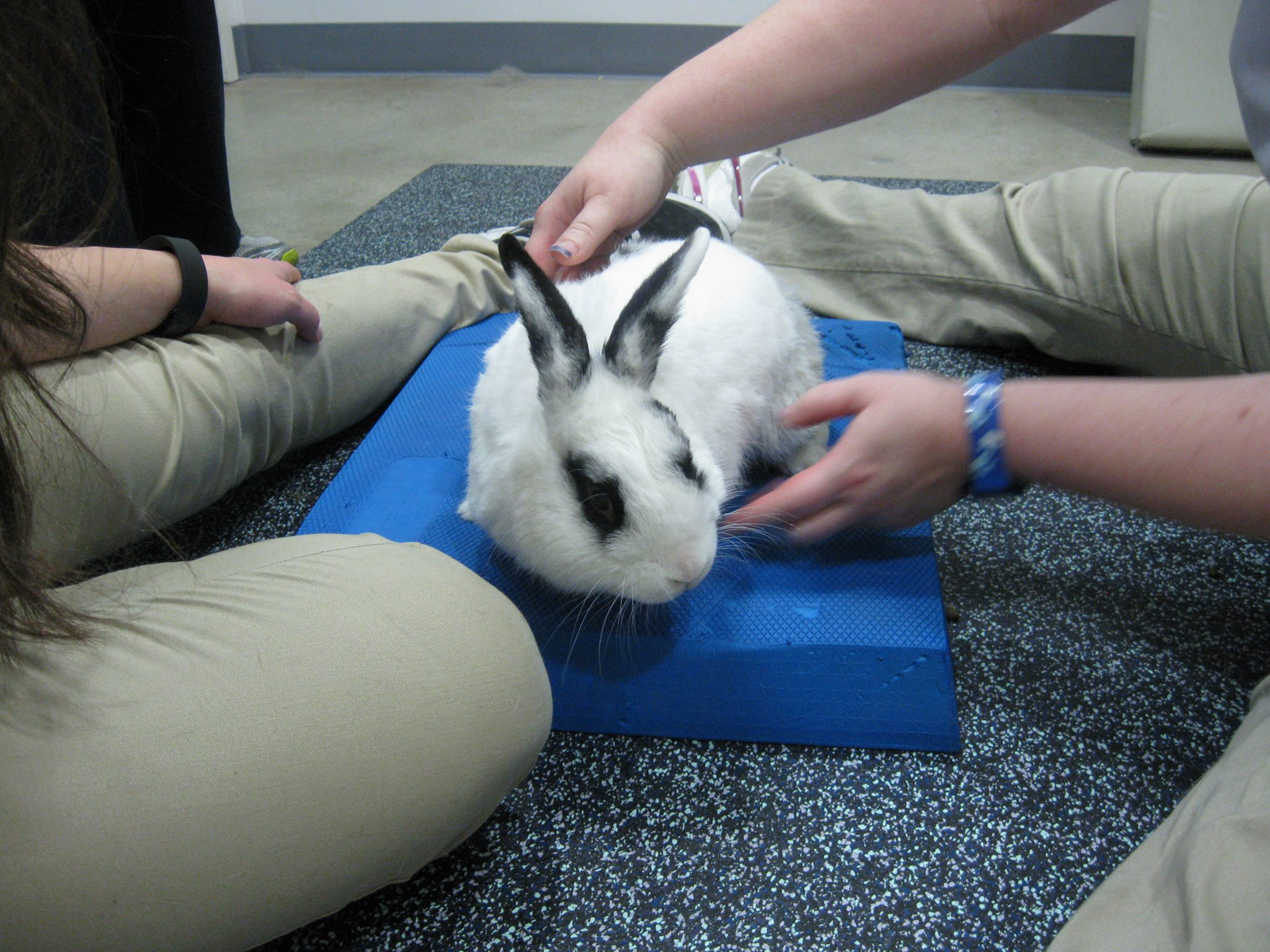 Diamond is being guided through his exercises by a team of physical therapists.
Diamond is being guided through his exercises by a team of physical therapists.Regardless if your bunny is suffering from an injury, arthritis or E. cuniculi, physical therapy may be of help to your pet. Vets specializing in orthopedics and physical therapy can often palpate structural changes and determine the level of pain the rabbit is experiencing in certain areas, such as neck, shoulders, lower back, knees and hips. Acupuncture, massage, cold laser therapy, targeted physical therapy exercises and underwater treadmill (should your bunny tolerate it) are all options that may greatly improve quality of life.
Most animal rehabilitation clinics primarily handle dogs. However, dogs and rabbits can suffer from the same spinal ailments, such a compressions, arthritis, spondylosis and weakness. If the animal rehabilitation clinic is willing to work with your rabbit-savvy vet, physical therapy can really help your bunny.
Rear End Paralysis: Supportive Care
 Petra (dark brown), Benji (brown and white) and Nat (white and black). At the time of this photo, only Petra had rear end paralysis. This was a temporary pen I would set up for the trio when I cleaned their pen, but still she was lying on towels and pee pads and had tons of cushions to make sure she was comfortable. It was important to make sure she was treated as the queen she thought she was.
Petra (dark brown), Benji (brown and white) and Nat (white and black). At the time of this photo, only Petra had rear end paralysis. This was a temporary pen I would set up for the trio when I cleaned their pen, but still she was lying on towels and pee pads and had tons of cushions to make sure she was comfortable. It was important to make sure she was treated as the queen she thought she was.Caring for a bunny with rear end paralysis requires a long-term commitment from the owner or caregiver. Keep your vet updated on your bunny's condition, so any potential health dangers such as pressure sores, can be addressed promptly.
Adjustments in the living area will need to be made. It's important to realize that setting up a pen for a rear end paralysis bunny is a work in progress. Every rear end paralysis rabbit is unique and his needs may change over time, so do not worry about "getting it right" at first.
Some points to consider:
- Litter boxes: You will need a low-entry litter box. Sometimes you need a box where one side is cut away completely, so the entry of the box is flush with the floor. This will probably mean the box will become more of a large hay rack than an actual litter box. I would avoid the temptation of placing your bunny in a litter box and leaving him there all day. The urine does not get wicked away, but rather soaks the fur and skin. Also the hay does not give enough gentle support, which can aggravate your bunny's condition.
- Flooring: Even if you have wall-to-wall carpet, but especially if you have hardwood floors, you need to give your bunny some extra padding. If you have hardwood, I would line your bunny's pen with rubber or foam flooring pads. If your bunny is still mobile enough to exercise, make sure he can get a good grip on some non-slip area rugs.
- Water and food bowls: Be aware of how you offer food and water. If your bunny needs to do push ups to eat and drink, that will not be comfortable. Try to raise the dishes. You may need to use a shallow bowl for water. If knocking over the water is a problem, you may have to use a water bottle or syringe-fed water.
- Cleanliness: Your bunny may have been a champ at keeping everything in the litter box at one time, but it would be unreasonable to have those same expectations now that he is disabled. Sheets and towels are not the best at absorbing urine and keeping your bunny clean and dry. Microfiber mats, microfleece, fake sheepskin and vet bedding are all good alternatives. Make sure any bedding you use does not have holes the bunny can get trapped in.
I would not recommend using diapers (pet or baby) as the diaper holds the waste close to the skin, causing urine scald and other skin issues. It ends up causing more problems than it solves.
I'd also stay away from disposable doggie pee pads. Sometimes they are chemically treated so the puppy knows to pee at the same spot every time. It's also easier for a bunny to destroy them.
Rear End Paralysis: What to Watch Out for
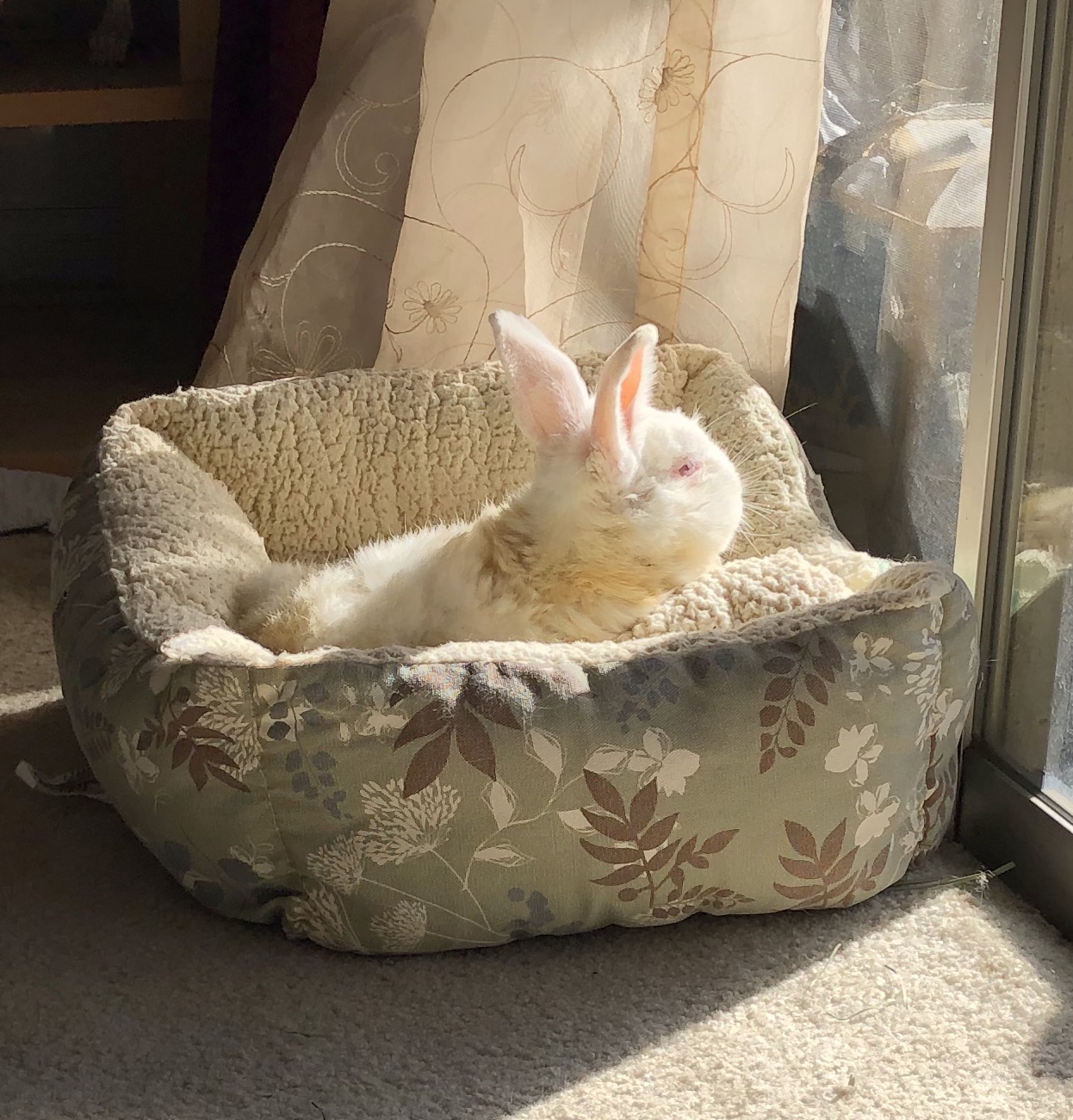 Eddie enjoying the afternoon sun.
Eddie enjoying the afternoon sun.Generally, you will always be monitoring your bunny's comfort and making sure he can reach his food and water. Since mobility is limited, you may need to feed smaller handfuls of food more often and watch that your bunny doesn't kick away any bowls of pellets or toss veggie stems out of reach.
Another important caregiver's task will involve keeping a rear end paralysis bunny clean and dry. Urine scald, poopy butt and pressure sores can inflame, irritate and ultimately break down the skin, inviting an infection. If your bunny spends a majority of his time on his side, you need to make sure the eye facing down does not dry out or get scratched.
Be aware of any sign of a respiratory issue, such as a runny nose or a rattle when breathing. An immobile rabbit will be at a higher risk of developing a bacterial infection and may need to be on an antibiotic like enrofloxacin.
With proper bedding, a bunny might only need to be checked twice a day. Changing up your bunny's position - having a "day bed" or spot on the couch as you both watch some TV can help avoid pressure sores as you shift your bunny's position. Pressure sores happen when a patient (animal or human) stays in one position for an extended time, limiting blood circulation and eventually breaking down skin.
Light massage of the hind legs and tickling the feet can keep nerves and muscles active and slow down muscle atrophy.
Snow Cone Jones - A ZCRR Sanctuary Rabbit
In early October 2020, Zooh Corner Rabbit Rescue picked up a badly injured baby rabbit from Kings County Shelter. She was a pretty blue-eyed angora, approximately 3-4 months old at the time. It was determined that she had spondylosis and sustained a spinal fracture on the L4-5 vertebrae, which caused a compression of the nerves and some rear end paralysis. The nerve damage compromised her ability to empty her bladder, and she needed help urinating several times a day.
Over time, there has been improvement. Although she can run and binky, she cannot urinate on her own and she has diminished muscle mass in both hind legs. She has good feeling in her left leg and foot, but her right leg - and especially her foot - is much weaker and she occasionally falls over. Her caretakers continue to provide physical therapy, massage and cold laser therapy in the hopes that she will continue to improve.
Click on the video below to see Snow Cone Jones run!
If you would like to donate to the continued care of Snow Cone Jones, Parsnip Malone (or any other Zooh Corner Sanctuary bunny), click here!
All photos and video courtesy of Zooh Corner Rabbit Rescue.
This little girl has no idea that she is partially disabled! When she came to us her back end was paralyzed due to a fracture on her spine and a compressed disc. She still has to have her bladder manually express several times a day because she can’t urinate on her own, and her right leg is far more of an issue than her left. She’s an amazing little girl. Goes to show what what a lot of TLC and fabulous veterinary care can do. Zooh Corner Rabbit Rescue sanctuary rabbit, Snow Cone Jones, is feeling quite a bit better. She is still on meds, and I will soon start to slowly taper them off again. Fingers crossed. We also need to observe her when she is playing because she gets so crazy, and we don’t want her to re-injure herself. Right now she’s getting shorter observed periods of playtime, not left alone. How adorable is she?
Posted by Cat Logsdon on Thursday, December 10, 2020
In Conclusion...
Rear end paralysis may happen for a number of reasons. It doesn't necessarily mean the affected bunny is doomed. The quality of life may not change much either, as long the bunny remains comfortable, clean and dry. A change in mobility does not affect a bunny's bond with his other bunny friends, nor does it need to negatively affect his bond with you. If you feel overwhelmed and confused, speak to your vet. You can also contact your local (or online) rabbit rescue. They are run by experienced rabbit owners who have seen pretty much everything. They are there to answer questions and can suggest other resources for you to check out. Facebook also has a number of rabbit groups in which you can ask questions. It can feel overwhelming at first, but once you have a routine established, it feels less daunting.
Further Reading
Brown, S. 2011. Hind Limb Weakness in the Rabbit. House Rabbit Society.
The information presented is for educational purposes only and does not substitute veterinarian care. This information should not be used for diagnostic purposes, for treatment of an illness or injury and never should be substituted for veterinarian care by a licensed veterinary practitioner. The Educated Rabbit cannot be held responsible for the accuracy of the information contained, nor be held responsible for any action, based on information found in the Educated Rabbit.
Seek advice from your veterinary professional for any rabbit health issues and before administering any drugs!
